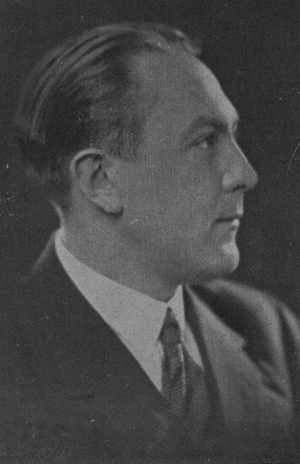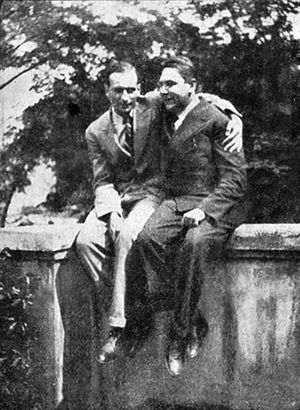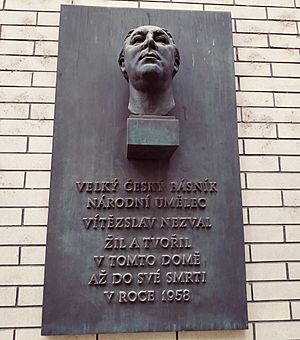Vítězslav Nezval facts for kids
Quick facts for kids
Vítězslav Nezval
|
|
|---|---|

Nezval in 1934
|
|
| Born | 26 May 1900 Biskoupky, Austria-Hungary |
| Died | 6 April 1958 (aged 57) Prague, Czechoslovakia |
| Resting place | Vyšehrad Cemetery |
| Occupation | Poet |
| Nationality | Czech |
| Notable works | Manon Lescaut Sbohem a šáteček The Absolute Gravedigger Woman in the Plural Valerie and Her Week of Wonders |
| Spouse | Františka Řepová |
| Signature | |
Vítězslav Nezval (born May 26, 1900 – died April 6, 1958) was a famous Czech poet, writer, and translator. He was one of the most active and creative Czech writers in the early 1900s. Nezval also helped start the Surrealist movement in his home country, Czechoslovakia.
Contents
About Vítězslav Nezval
His father was a school teacher in a village called Biskoupky. His father loved art and music. He even studied music with the famous composer Leoš Janáček.
When Nezval was eleven, he went to a special school in Třebíč. There, he learned to play the piano and compose music. He started writing poems and stories when he was a teenager. Even then, he was still very interested in music. People said he would play his accordion while looking at the stars!
In 1918, he joined the Austrian army. But he soon got sick and was sent home. After World War I, Nezval moved to Prague. He began studying philosophy at Charles University. However, he did not finish his degree. During this time, he loved the lively world of writers and artists in Prague.
Nezval's Creative Work
Vítězslav Nezval was part of an exciting art group called Devětsil. This name means "nine forces" in Czech. It was also the name of a plant, but it hinted at the nine founding members of the group. The Devětsil members were some of the most creative Czech artists of their time.
In 1922, the Devětsil group included Nezval, Jindřich Štyrský, Jaroslav Seifert, Karel Teige, and Toyen (Marie Cerminová). Another person linked to the group was Roman Jakobson. He later started the Prague Linguistic School.
Like earlier art groups, Devětsil looked to France for new ideas in art and writing. They also were interested in Marxist political ideas from Russia. Even though Czechoslovakia was a new country after World War I, young people felt it could be even better. They believed big changes were needed for true freedom. Many of these thinkers were excited about revolution. They supported Lenin's ideas. Their president, Thomas Masaryk, gave them a fair democracy. But Nezval and his group felt it did not fully represent their beliefs. In their writings, they showed they preferred the idea of all people working together.
Poetism and New Art Ideas
The first message from Devětsil told young artists to find beauty in everyday things. They said that skyscrapers, airplanes, and even posters were new forms of art.

Nezval also helped create something called Poetism. This was a style within Devětsil, mainly thought up by Karel Teige. Nezval wrote many poetry books, experimental plays, and novels. He also wrote memories, essays, and translated other works.
Nezval, Karel Teige, Jindřich Štyrský, and Toyen often visited Paris. There, they met French surrealist artists. Nezval became good friends with André Breton and Paul Éluard. This friendship helped him start The Surrealist Group in Czechoslovakia in 1934. It was one of the first surrealist groups outside France. Nezval was the editor of its magazine, Surrealismus.
Special Projects
For Nezval's book Abeceda (meaning "alphabet"), the Devětsil dancer Milča Mayerová created special poses for each letter. Nezval wrote this poem about how the letters look, sound, and work. Teige used special printing and photo collages to show these poses in the book.
Nezval's poem Sbohem a šáteček (meaning "Waving farewell") was written in 1934. A Czech composer named Vítězslava Kaprálová set it to music in 1937. The orchestral version was first played in 1940 by Rafael Kubelik.
Later Years
After Germany took over Czechoslovakia, Nezval joined the secret group fighting against them. He was put in prison in 1944.
After Czechoslovakia was freed, Nezval received many awards for his work. He tried to keep his Poetism ideas alive. He also tried to fit them with Socialist realism. This was the new official art style approved by the government. He was active in politics and became the head of the film department for the Ministry of Information.
Nezval's health started to get worse after 1950. On April 6, 1958, he died in Prague. He had pneumonia and then heart failure. A first memorial service was held at the Rudolfinum. He received a state funeral on April 10. He was buried at the Vyšehrad Cemetery in Prague. His writings are now kept in the archives of the National Literature Memorial.
See also
 In Spanish: Vítězslav Nezval para niños
In Spanish: Vítězslav Nezval para niños
- Edison (poem)


